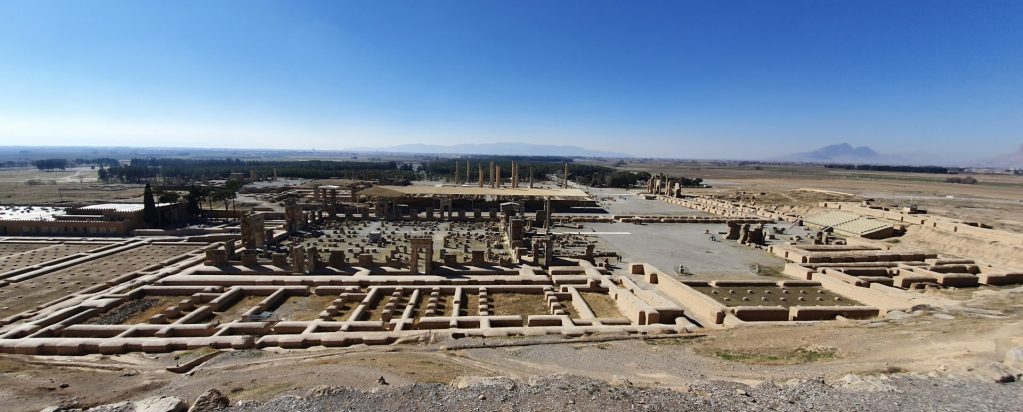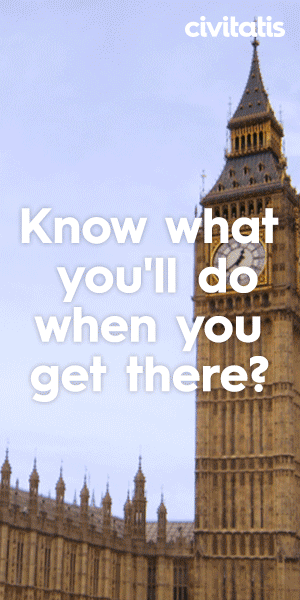Takht-e Jamshīd was the ceremonial capital of the Achaemenid Empire. It’s better known today as Persepolis. The site was added to UNESCO in 1979.
Here’s why you should visit Takht-e Jamshīd and what you should know beforehand. With a lot of pictures of what you’ll see.
Visiting Persepolis in Isfahan Iran
Takht-e Jamshīd | Persepolis | Construction
Takht-e Jamshīd meaning the Throne of Jamshid and also known as Persepolis was built during the early Achaemenid empire. The earliest artefacts at Persepolis date to around 515BC. Indicating it was built during the reign of Darius I.
Darius ascended the throne by killing the youngest son of Cyrus The Great after he took over the throne from his elder brother.
The citadel at Persepolis was then expanded by Xerxes I and Artaxerxes I. Some of the compounds such as the Apadana Palace were rebuilt by Artaxerxes after being damaged by fire during his reign.

Destruction of Persepolis | Who Destroyed Persepolis?
Alexander the Great destroyed Persepolis around the mid 3rd century BC. But not during the taking of Persepolis. Rather Alexander resided at Persepolis for approximately 6 months before the city was eventually burned.
I actually thought the city was destroyed in its siege and capture. And didn’t know Alexander stayed at Persepolis which I learnt from the audio recording provided by the site. I would recommend all visitors to the site get an audio guide.
From the audio guide I gleaned that Alexander had set fire to the city as retaliation for Xerxes I burning parts of Athens years earlier.
Takht-e Jamshīd | The Gate of All Nations | Gate of Xerxes
Seemingly the main drawcard for most visitors to Persepolis is the The Gate Of All Nations and the grand staircase leading up to it. Also known as the Gate of Xerxes this huge doorway was the main portal into Persepolis.
Looking at the staircase and the gate it’s a wonder that Alexander’s forces were able to penetrate let alone conquer Persepolis. The staircase splits in two directions allowing defence from high ground.
And if a force does get to the top of the staircase in sufficient numbers then falling back into the Gate of Xerxes funnels the invaders forces into a narrow hall. Allowing attack from above and perhaps the sides. It’s the sort of place that Alexander really wouldn’t have wanted his men to meet the Persian Immortals head on.
But beyond its utility as a defensive structure the gate functioned as, well, a gate. It was the main thoroughfare into and out of the citadel. Its sheer size and grandeur would have been compelling for emissaries visiting Takht-e Jamshīd or the throne of Jamshid with tribute.
I certainly would have found the Achaemenid Kings claim to rule over my lands compelling. Based entirely on the size of the door built at Persepolis.
I found it difficult to get a clear look at the Gate of Xerxes due to all the photos and selfies everyone was taking. So I’d advise visiting early in the morning or late in the afternoon if the Gate of Xerxes is what you’re most interested in.






Ahura Mazda | Religion at Persepolis
The state religion of the Achaemenid Empire was Zoroastrianism. A religion much older than Christianity. The character at the top of the two images below that looks like a mans torso where a birds head should be is Ahura Mazda.
Ahura Mazda is the supreme deity in the Zoroastrian religion. He’s the supreme god in heaven and the creator of everything. Including himself. In Zoroastrianism Ahuramazda is the entity said to have revealed himself to Zoroaster and is the creator of all things without whom there would be nothing in existence.


Reliefs | The pictures and what they mean
Seen all over Perseoplis is the image of a lion attacking and eating a bull. The image itself is a Zoroastrian symbol for Nowruz. Nowruz is the Iranian New Year marking the spring equinox and is still practiced by most Persians.
One theory for the use of Persepolis as the ceremonial capital of the Achaemenid empire due to its remote location is as a site for celebrating events like Nowruz.
The second most common type of reliefs are those featuring soldiers with spears and bows. From what I heard and read these are perhaps meant to represent the Immortals. A 10,000 strong standing army who were the professional Persian soldiers and who’s elite members formed a 1000 strong contingent of kings guard.
Not to be confused with the soldiers are the third most common depiction in the reliefs present at Persepolis. And those are the subjects bringing gifts and carry alms for the king. In the fourth image below you can see a long line of characters carry items and leading livestock. These would have been emissaries transporting livestock and carrying gifts for the king.




Takht-e Jamshīd | Statues at Persepolis
There were 3 dominant statue motifs that I saw at Persepolis. Those were bulls, lions and the Huma bird. As mentioned above, the lions and bulls were also dominant in the reliefs. And when taken together were a religious Zoroastrian symbol for Nowruz.
Lions and bulls topped the Palace of 100 Column or Apadana Palace. Persian Mastiff statues were placed on the ground around the Apadana Palace.
Removed from the site and not visible at Persepolis, at least as far as I could see, were the Persian Mastiff statues. I did see the Mastiffs on display at the National Museum in Tehran. And those were taken from Apadana Palace at Persepolis.
The two headed statue in my photo below is of a Huma bird. Sometimes spelt Homa. The Huma bird is of ancient Persian mythology and is said to never touch the ground. In ancient Persian mythology and Persian Sufi and Diwan Poetry the bird never touches the ground but instead flies invisibly overhead. Seeing one is said to bring luck.




Takht-e jamshīd | Persepolis | Graffiti
An interesting facet of the site at Persepolis is the graffiti and just how old some of it is. I can’t find it in my photos of the site now, but the oldest graffiti I saw during my visit was dated to the early 18th century.
As an Australian I found it quite entertaining to learn that Iran has graffiti that is almost as old as my country. Which really puts into perspective just how much history the Persian people and Iran have. They have graffiti older than a lot of extant nations and graffiti that is almost as old as my own country.
The other aspect I got from the graffiti is it shows that the social problem of people with spray cans putting their names all over public property isn’t new. Spray cans are a development of the last few decades. But before modern tools people still put their names all over public property for posterity.



Takht-e Jamshīd | Getting to Persepolis
There aren’t any buses or trains to Persepolis. You’ll either need a hire car or to book an organised tour. And unless you’re familiar with Iranian road rules you probably shouldn’t drive yourself. Iranian traffic is intense and road rules are rarely followed. I’ve seen people in Iran reverse down a freeway in peak hour traffic.
When we visited we had a van and driver for the day. We completed a circuit starting at Persepolis and then moved to Naqsh-e Rostam and Ka’ba-ye Zartosht before finishing at Pasargade and the Tomb of Cyrus.
I would advise you to look into combining Persepolis with Naqsh-e Rostam which is the Necropolis of four Achaemenid kings carved into a nearby cliff. And Pasargadae where the main drawcard is the Tomb of Cyrus The Great. The founder and first king of the Achaemenid Empire. I’ve got reviews of both on this site.
If I were to ever find myself back in Fars Province of Iran I’d do the 3 sites again as a circuit. However I would likely do them in reverse order.
I’d start at Pasargade and move to Naqsh-e Rostam and then finish at Takht-e Jamshīd. I would go in this reverse order to move from earliest to latest sites. Or from the least remaining artefacts to the largest site with the most remaining artefacts. Because after Persepolis everything else just feels a little less grand.
Of all the sites in Fars it is Persepolis that has the wow factor. Walking up to the site’s grand double staircase and getting a sense of the cities scale from its raised foundations; is just awe inspiring. The other sites around the area are amazing in their own right. Yet they simply aren’t as large or as grand as the Throne of Jamshid (Persepolis).
Visiting Persepolis | Time Needed
When we visited Persepolis we found that even though the site is large and there is a lot to see, we only needed half a day. I’ve seen people claiming you would need a full day to see Persepolis. But I can’t imagine spending a full day at the site. Unless we were to spend an excessive amount of time at the kiosk we wouldn’t haven been able to fill a full day.
I’d recommend allocating either a morning or an afternoon to seeing Persepolis. Don’t go midday. You will regret it if you do. I found that it gets very hot at Persepolis. So I was glad we brought sunscreen or I would have been cooked. I saw little to no shade on site to avoid the sun. And I saw nowhere nearby selling hats or sunscreen so make sure to take some.
Based on my own experience of visiting the site in the morning and then doing the circuit to Naqsh-e Rostam and Pasargadae; I’d say that the best time to go is in the afternoon. Watching a sunset over Persepolis would be on my bucket list of things to do.
Takht-e Jamshīd | Conclusion
I’ve visited a lot of UNESCO World Heritage Sites over the years. Including places like Machu Picchu in Peru or Colonial Del Sacramento in Uruguay. But nothing has been as grand or as awe inspiring as Takht-e Jamshīd or the Throne of Jamshid.
The ceremonial capital of the first great Persian empire is a site everyone should visit. At least once in their lifetime but twice would be better!
I also visited the National Museum in Tehran. And I would recommend to everyone visiting Persepolis to also visit the National Museum. As I mentioned briefly above the National Museum has many relics relevant to Persepolis.
I found the National Museums exhibits combined with my visit to the site helped better contextualise what I was seeing at Persepolis.
I’d also recommend that everyone visiting the site take up the offer of an audio guide. I found it very easy to use at each point in the complex and for me it made what I was seeing make a lot more sense. If I had not have had the audio guide I would have spent most of my time trying to decipher each pile of columns or statues.
To me Persepolis resembled a huge lego set. There were pieces everywhere. And without some sort of context like I got from the audio guide it would have been a lot less interesting.
Liked this article? Subscribe to the blog below and check out our other travel articles on Iran.
bonus pictures of persepolis تخت جمشید

























